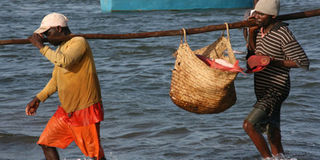Breaking News: Old Kijabe dam tragedy: Death toll rises to 45
First underwater museum to be established in Kilifi County

Malindi Fishermen carry a bagful of fish from a dhow off the Malindi Ngomeni Coastline. The National Museums of Kenya will partner with China to establish the first under water Museum in Kenya in Indian Ocean off the Ngomeni Coastline in Kilifi County. PHOTO | ROBERT NYAGAH | FILE
What you need to know:
- Under the project, the government of China has assisted Kenya train its first ever underwater archeologists Caesar Bita and Philip Wanyama and also to procure underwater archeology equipment.
- The Ngomeni shipwreck would be conserved after a study of the artifacts recovered from it are completed in Kenya and the Peking University Archaeology and Museology in China.
- Shifan Wu said it is believed that some of the Zheng He sailors were involved in a shipwreck off the Kenyan Coast with survivors remaining in Kenya and intermarrying to create an African – Chinese community whose descendants are scattered along Lamu Islands.
The National Museums of Kenya will partner with China to establish the first under water Museum in Kenya.
Culture, Sports and the Arts Cabinet Secretary Dr. Hassan Wario said the Museum will be established in Indian Ocean off the Ngomeni Coastline in Kilifi County.
The plan is culmination of the discovery and collection of various artifacts among them those unearthed from two shipwrecks in the Indian Ocean waters of Malindi and Lamu.
Archeologists displayed the various items recovered from a shipwreck discovered in the Indian Ocean off the Ngomeni Coastline which included lead metals, copper ingots, Chinese ceramic and pottery, strip and plates for ship building and coagulated concrete artifacts.
The National Museums of Kenya, Dr. Wario said, has already started a process of gazzetting the Ngomeni shipwreck site to ensure its protection
Addressing Kenyan and Chinese archeologists at the Karibuni Villas Hotel in Magarini District in Kilifi County at the end of a three year Sh200 million archeological project sponsored by the Chinese government, Dr Wario also announced plans for the establishment of a Museum to specifically conserve and display underwater cultural resources.
Under the project, the government of China has assisted Kenya train its first ever underwater archeologists Caesar Bita and Philip Wanyama and also to procure underwater archeology equipment.
The minister said the underwater archeology was a relatively new and expensive undertaking in Africa and Kenya’s partnership with China placed it ahead of many regional African states in this area of specialization.
He said Kenya was pursuing more partnership with China in the field of underwater archeology and the just ended project christened Sino-Kenya Underwater Archeology Project may be extended for another three years and attract similar funding.
The main aim of the project, the minister said was to carry out archeological research both on land and underwater in order to ascertain ancient Chinese presence along the Coast of Kenya.
Partly, the team investigated cultural materials with Chinese connections from the sites already excavated by local and foreign researchers in Lamu, Kilifi and Tana River counties.
The Ngomeni shipwreck would be conserved after a study of the artifacts recovered from it are completed in Kenya and the Peking University Archaeology and Museology in China.
“The Ngomeni Shipwreck is believed to be Portuguese in origin although further excavations will authenticate that hypothesis,” said Dr. Wario.
With only a quarter of the shipwreck excavated, the minister noted that more time and resources were required to excavate the shipwreck which was buried deep in the base of the Indian Ocean waters.
Dr. Wario said terrestrial archaeology had opened up new thinking in archeological research and Kenya was keen to expand its programs to discover more from the waters of the Indian Ocean.
He noted that with the recovery of a Chinese coin during excavations in Mambrui area of the Kilifi County in 2010 the “prehistory of the region has been found to go back to metallurgical period.
Excavations in Malindi town outside the Malindi Chief’s Office, Dr Wario noted opened new insights into the habitation of the town.
“The ruined settlement recovered behind the Malindi Museum demonstrated that Malindi town economically strived prior to the arrival of the Portuguese and the Chinese.
Chinese embassy spokesperson Mr. Shifan Wu said Kenya and China would continue to strengthen cultural and historical links through formation of a team of experts to trace historical connections between the two countries.
He said the countries’ friendship started more than 600 years ago when Chinese navigator Zheng He visited the Kenyan Coast in one of the largest ships then.
Shifan Wu said it is believed that some of the Zheng He sailors were involved in a shipwreck off the Kenyan Coast with survivors remaining in Kenya and intermarrying to create an African – Chinese community whose descendants are scattered along Lamu Islands.
One of the descendants of the Chinese sailors, Ms Mwamaka Sharifu Lali, the Chinese envoy said was offered a Chinese government scholarship to study traditional medicine at the Nanjing University of Traditional Chinese Medicine qualifying to become a Doctor.
Dr. Sharifu is presently undertaking internship at the Nanjing Municipal Hospital in China and is expected to return to Kenya and start practicing medicine.




